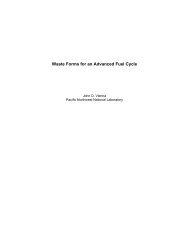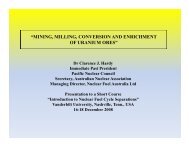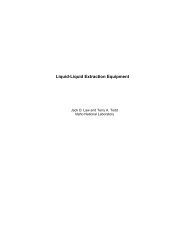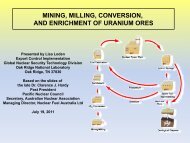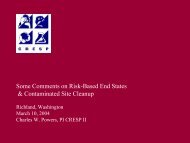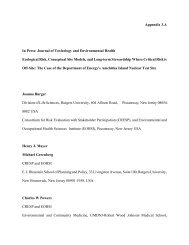Follow-up letter October 2006
Follow-up letter October 2006
Follow-up letter October 2006
You also want an ePaper? Increase the reach of your titles
YUMPU automatically turns print PDFs into web optimized ePapers that Google loves.
IRMThe Institute for Responsible Management200 Centennial Avenue, Suite 200Piscataway, New Jersey 08854Tel. 732-235-3460 Fax 732-235-9607www.cresp.org<strong>October</strong> 26, <strong>2006</strong>Mr. Joel T. CaseIdaho National LaboratoriesP.O. Box 1625Idaho Falls, ID 83415Dear Mr. Case:This <strong>letter</strong> report is a follow <strong>up</strong> to our <strong>letter</strong> report of September 11, <strong>2006</strong> to present results of ourreview of the revised report 1 on the pilot studies carried out in s<strong>up</strong>port of design of the steamreforming (SR) process for treating sodium bearing liquid wastes (SBW) currently stored in Tanks187, 188 and 189 at the Idaho National Laboratory. The revised pilot plant report provides muchmore extensive documentation and analysis than the earlier draft we reviewed, which in-part formedthe basis for our evaluation provided in the <strong>letter</strong> report of September 11, <strong>2006</strong>. The reviewpresented in this <strong>letter</strong> report represents a consensus of all four members of the review team 2 .The stated primary objectives of the testing program “were to demonstrate that integrated operationof the treatment process confirms key design and operating parameters for the full-scale treatmentprocess, and provides process off-gas data to s<strong>up</strong>port environmental permitting of the full-scaleprocess.” 1 Our review of the revised report is in the context of this stated set of objectives and thefindings and recommendations provided in our <strong>letter</strong> report of September 11, <strong>2006</strong>.In summary, we conclude that the project team successfully completed a high quality pilot-testingprogram and provides excellent documentation and analysis of the results of that program in therevised report. The revised report clearly addresses our Recommendation 1 of September 11, <strong>2006</strong>to provide more thorough documentation and analysis of the pilot studies that have been completed.In addition, we recognize that additional testing could not yet have been carried out in response to ourearlier recommendations and the need for additional testing that addresses many of our earlierrecommendations is clearly identified in the revised pilot plant report. Thus, we conclude thatRecommendations 2 through 17 of our earlier review have not been resolved in the revised report,although many have been acknowledged.Review of the more extensive documentation and analysis of the pilot-scale testing results providesthe basis for the additional findings and recommendations indicated below. The high quality andextensive data gathered during the pilot-scale testing also presents several opportunities for use ofthe information gained for the benefit of the full-scale design and operations. These opportunities arealso described below.1 Pilot Plant Report for Treating Sodium-Bearing Waste Surrogates - Carbonate Flowsheet (DRAFT),rev. 1, Thor Treatment Technologies and Washington Gro<strong>up</strong> International, project number 28276,document number RT-ESTD-002, Aug. 31, <strong>2006</strong>.2 This review was substantially completed under CRESP II prior to Sept. 29, <strong>2006</strong> and is now issuedfollowing completion of factual accuracy review by DOE-ID and DOE-EM on Oct. 25, <strong>2006</strong>.
ADDITIONAL FINDINGS AND RECOMMENDATIONSFinding 18. Waste feed nozzle design, control of the distribution system for process feed streams(wastes, gases, s<strong>up</strong>plemental carbon), temperature control, and solids management duringprocessing (e.g., use and maintenance of a strainer to remove oversized particles in the waste feed,removal of solids from the CCR, particle size management in the DMR, recycle of unreacted coalparticles) are important components that will impact process availability but have not been fullyresolved.Recommendation 18. Clear performance and reliability criteria should be established for criticalprocess components and systems such as these and others, with additional testing carried out asnecessary to demonstrate that the specified performance and reliability criteria can be attained.OPPORTUNITIES FOR ADDITIONAL BENEFICIAL USE OF PILOT TESTING RESULTSOpportunity 1. Overall system availability will be important for estimating and achieving anticipatedwaste processing schedules. Data from the testing completed to date, and from operation of thefacility at Irwin, TN, may be developed into a suitable database and analyzed to determine specificprocess component reliability, and plan for outages and preventative maintenance.Opportunity 2. Actual pilot system performance can be compared with assumptions used duringsafety analysis to provide a better understanding of overall system safety management. Forexample, (i) assumed <strong>up</strong>set scenarios during system analysis and those observed during testing canbe compared to form an integrated understanding that can be used to plan future tests of responsesto <strong>up</strong>set conditions and shut down systems, (ii) mass balances on trace species obtained during pilottesting can be used to <strong>up</strong>date expected radionuclide inventories in different parts of the processduring operations, thus improving dose calculations to workers and during accident scenarios, and(iii) testing a few failure combinations may provide important insights on accident initiating conditionsto avoid, especially given the need for the process to operate as an integrated system.CLOSINGThe review team is available to answer any questions about this report or the review processes. Inaddition, the review team can review future pilot-scale test plans and reports on pilot-scale testing ifrequested.Sincerely,David S. Kosson, Ph.D.Chairman, Review TeamB. John Garrick, Ph.D., P.E., NAEReview Team MemberJames F. Mathis, Ph.D., NAEReview Team MemberStanley I. Sandler, Ph.D., NAEReview Team Membercc:R. Provencher, DOE-ID M. Gilbertson, EM-20 C. Powers, CRESPW. Owca, DOE-ID I. Triay, EM-3



